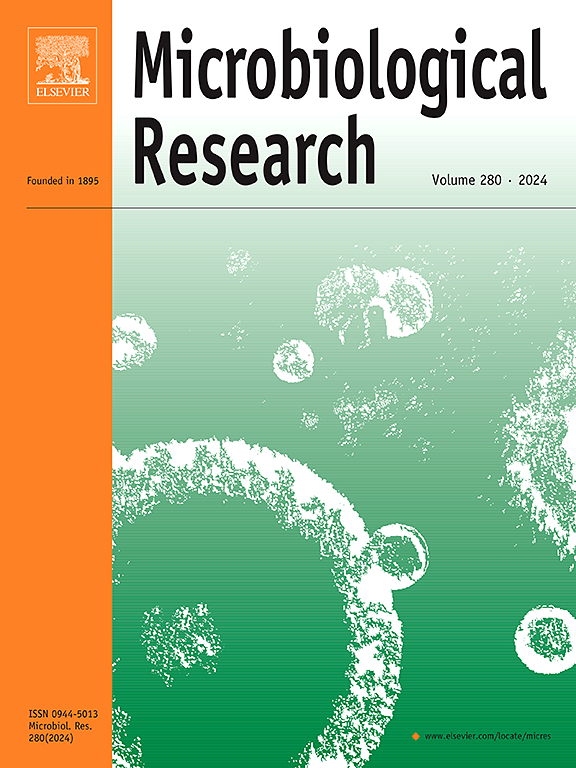Cystathionine γ-lyase is an essential biocontrol-positive regulator of Trichoderma gamsii strain TC788
IF 6.1
1区 生物学
Q1 MICROBIOLOGY
引用次数: 0
Abstract
Some Trichoderma strains have been widely used in agriculture due to their biological control functions against plant pathogens. However, only a few intracellular biocontrol-related factors of them were explored. In this study, T. gamsii strain TC788 was discovered possessing comprehensive antagonistic capacity to the fungal phytopathogen Rhizoctonia solani causing damping-off disease of pepper, in which cystathionine γ-lyase is proved to be an essential biocontrol positive regulator as evidenced by combined analyses of transcriptome and proteome, proteins interaction network, and gene homologous recombination. Overexpression of cystathionine γ-lyase significantly up-regulated expression levels of six pathway proteins and enzyme activities of secreted proteins associated with biocontrol. It also increased contents of cysteine and hydrogen sulfide in enriched pathway of cysteine and methionine metabolism, and improved concentration of the main volatile organic compound, 6‑pentyl‑2H‑pyran‑2‑one, by 4.18 times. Pot experiments further confirmed that overexpressed strain of TC788 enhanced inhibiting ability against R. solani, promoted growth indicators, and induced systemic resistance of pepper seedlings compared with wild type strain. This work provides theoretical bases of biocontrol effects performed by strain TC788 against the phytopathogen, and explores preliminarily interaction between the strain and pepper plant.
半胱硫氨酸γ-裂解酶是甘氏木霉TC788重要的生物防治阳性调节因子
一些木霉菌株因其对植物病原菌的生物防治作用而在农业中得到了广泛的应用。但对其胞内生物防治相关因素的研究较少。本研究发现,甘氏T. gamsii菌株TC788对辣椒萎蔫病病原菌番茄根丝胞菌具有全面拮抗能力,通过转录组学和蛋白质组学、蛋白质相互作用网络和基因同源重组等综合分析,证实其胱硫氨酸γ-裂解酶是重要的生物防治正调控因子。过表达胱硫氨酸γ-裂解酶可显著上调6种途径蛋白的表达水平和生物防治相关分泌蛋白的酶活性。提高了半胱氨酸和蛋氨酸代谢富集通路中的半胱氨酸和硫化氢含量,使主要挥发性有机化合物6 -戊基- 2H -吡喃- 2 -酮浓度提高了4.18倍。盆栽试验进一步证实,与野生型菌株相比,过表达菌株TC788增强了辣椒对番茄枯萎病的抑制能力,促进了辣椒幼苗的生长指标,诱导了辣椒幼苗的全身抗性。本研究为菌株TC788对病原菌的生物防治作用提供了理论依据,并初步探讨了菌株与辣椒植株的相互作用。
本文章由计算机程序翻译,如有差异,请以英文原文为准。
求助全文
约1分钟内获得全文
求助全文
来源期刊

Microbiological research
生物-微生物学
CiteScore
10.90
自引率
6.00%
发文量
249
审稿时长
29 days
期刊介绍:
Microbiological Research is devoted to publishing reports on prokaryotic and eukaryotic microorganisms such as yeasts, fungi, bacteria, archaea, and protozoa. Research on interactions between pathogenic microorganisms and their environment or hosts are also covered.
 求助内容:
求助内容: 应助结果提醒方式:
应助结果提醒方式:


